What if V.S. Naipaul were a happy man? What if V.S. Pritchett had loved his parents? What if Vladimir Nabokov had grown up in a small town in western Nigeria and decided that politics were not unworthy of him?
I do not take, or drop, these names in vain. Wole Soyinka, the Nigerian novelist, playwright, critic and professor of comparative literature, belongs in their company. It is a company of children who grow up without forgetting anything, children who sing in a garden of too many cultures. Behind each shrub, there is an ambush of angel or demon.
Mr. Soyinka has already written one sort of autobiography, "The Man Died," and it was fine. But it was about adult life. "Ake," his account of his first decade, 1935 to 1945, is of another, higher order. It locates the lost child in all of us, underneath language, inside sound and smell, wide-eyed, brave and flummoxed. What Waugh made fun of and Proust felt bad about, Mr. Soyinka celebrates, by touching.
From the beginning, before he was 3 years old, when he wanted to go to school because school was the place of books, he had a reputation: "He will kill you with questions," they said. And why not? Every intelligent child is an amateur anthropologist. The first thing such a child notices is that adults don't make sense.
He was as bookish, to drop another name, as Jean-Paul Sartre. But when Sartre came to write his "Words," he had forgotten how to be a child; Mr. Soyinka remembers absurdity, friendship, ridicule, bedwetting, pomegranates, goats, bicycle bells, cutlasses cut from barrel hoops, weddings at which everybody arrived in clothes that didn't fit, snoring in the bedroom, wasps in the ceiling, shoes and cliches, medicine and prayer: "I noticed that God had a habit of either not answering one's prayers at all, or answering them in a way that was not straightforward."
He noticed everything. His father, Essay, was with "wicked patience" the headmaster of a Christian grammar school. His mother, Wild Christian, ran a shop, professed nonviolence and beat him with a stick. His uncle initiated him into Yoruba mysteries by using a knife on his ankles and his wrists. On his worrying, out in the bush, that a huge snake might "jump down" from a tree, he was told, "Speak English to it."
He was also a troublemaker, following the loud music of the Police Band well beyond the boundaries of his parsonage, stealing books, failing to weed the school lawn, eating the powdered sugar intended for his younger siblings, refusing to fling himself at the feet of the local king: "If I don't prostrate myself to God, why should I prostrate to you?"
Isn't this enough ambivalence to launch a career in contemporary Western literature? We are reading about English colonialism and Yoruba folk myth, the Bible and the hex, irrational parents, pregnant madwomen, nightmares of demonic possession, fear of "CHANGE," radio programming schedules that begin and end by asking God to save the wrong king, language as alien as black and white. A "rare event" is "a grown man who was unabashedly happy."
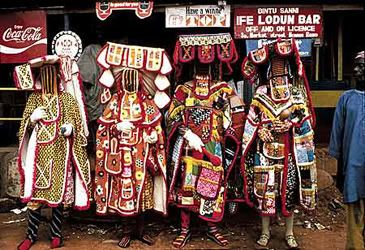
And yet Mr. Soyinka, hearing the cries of Ake's market and the chime of the tower-clock; spying on the "song-master" who leads a procession of humiliated women from house to house down mean African streets, past church, cemetery, sewing academy, barbershop, repair shack, "mounted divination birds" and "elephant-topped" archways to a fake palace; eating, for joy, black-eyed beans that have been crushed and skinned and mixed with melon-seed oil, and ingesting, as a cure for the wet bed, roasted egg-nest of praying mantis; dreaming of a dead father and a shoeless child -this Mr. Soyinka somehow, marvelously, makes ambivalence cheerful.
His book is a confection that stings. By learning to know some of Ake, we are educated to appreciate a little of imperialism. After all the palm oil, kola nuts, cowrie shells, dead dogs, old coins and new blood, Mr. Soyinka chuckles so hard that we almost forget why birds died in his garden. Childhood is something from which he wants to graduate, because his questions haven't been answered and that kills him.
Most of "Ake" charms; that was Mr. Soyinka's intention. The last 50 pages, however, inspire and confound; they are transcendent. The women of Ake perceive unfairness in the fact of a new tax law and in the person of a white District Officer. As they agitate, young Soyinka is their courier, as if from culture to culture, from mother to son. The revolution that these women make in a place as remote from us as childhood is better than anything dreamed up by John Reed in the late St. Petersburg.
Black women are insulted by a white man. They reply: "You may have been born, you were not bred. Could you speak to your mother like that?" It then occurs to them to cut off his genitals and mail a message to his mother. They refrain, but I won't. This brilliant book, this wonderful message, is too kind.
– Review by John Leonard, published September 23, 1982,
in the New York Times Book Review
I did not own a copy of
Ake till 2001 but first read it in 1990. I was amazed to find that the local library in our small Nevada town outside Las Vegas stocked it. The beautifully-illustrated abridged edition is therefore the third read of Wole Soyinka’s journey back to his childhood, a journey the abridged edition makes vivid for the younger readers.
Tony Marinho may be a successful medical practitioner but if Nigeria was a country where people read, he would most probably have forgotten this day job long ago. He would be churning out medical fiction like Robin Cook’s medical mystery thrillers. Tony’s also a social crusader in the mould of Soyinka, Gani, Umar, Falana, et al. But for the crowd that awaits him each morning at his Ibadan Clinic – a means to a livelihood – I’m sure Tony would most likely be a full-time writer. In spite of this necessary impediment, Tony makes time for Educare Child Trust that he and other like-minds promote, writes a weekly column for this newspaper where his essays consistently drip with all of our deep social and political frustrations. Abridging Soyinka’s lovable autobiographical memories into a form that younger kids can understand and enjoy fulfills his interest in children AND reading habit. We all owe Dr. Marinho many thanks for this addition to the sparse literary offerings for Nigerian children.
Bookcraft’s cover design is enticing, whetting the appetites of little kids that the subject is from their world, a world of day-dreaming, of care-free adventures, of dangerous scrapes just as the subject they are about to meet got into many in those pre-computer era when kids did a lot of exploring outside. The illustrations are good.
This abridgement is as good as any on the works of the old masters from my childhood: Dickens, Stevenson, the Bronte Sisters, etcetera, books that built children’s English vocabulary without their realizing it while opening for them windows into worlds they could barely imagine or hardly understand. A child read an abridged edition at ten or the pre-teen years and sinking her teeth into the later bigger volumes becomes a thing of desire. Back in the mid-70s when I was into fast-paced Robert Ludlum books – you could pick them up for affordable prices on the sidewalk in front of Radio Nigeria, Ibadan – a friend who had majored in English at UI saw the last of the Bourne trilogy,
The Bourne Ultimatum and wondered why I was always reading "fat books". A sibling who had studied English at UI earlier melodramatically threatened to make a bonfire of her degree "in front of Trenchard Hall with the World Press covering it" because a UI degree in English in her days meant that you had moved well past a fear of "fat books"!
At the end of the abridged
Ake are questions on each chapter which will help parents, guardians and teachers. Difficult words are in bold letters, words that are subsequently listed alphabetically at the end. "Yoruba terms used... and their meanings" are also shown at the end. At the bottom of each of the two copies I’m giving grandkids, I annotated the meanings of
Abe [under]
okuta [rocks], "Abeokuta is a city of rocks...";
Daodu [generally, male heirs], an affectionate name by which succeeding generations of Abeokuta Grammar School students refer to the late "Rev. Ransome-Kuti (Fela’s father)", etcetera.
While this abridged form may be for children, addressing this review to readers of my essays has two purposes: get those who may not have read the adult edition see what they’ve been missing and get pre-teen kids – and older ones – either start a love affair with books or strengthen an existing one. Even for those adults who believe Soyinka’s works are "difficult" – a few could be technically challenging –
Ake and the latter
You must set forth at dawn – aren’t the only "easy" Soyinka books as thousands of high school students who have read – or dramatized – the hilarious
Lion and the Jewel, or the historical
Death and the King’s Horseman can attest to.
Soyinka is outrageously funny and I barely know him beyond his books but this funny side seems generally overlooked because of the seriousness of his many battles for societal equity and justice. Kids will meet Osiki, a friend he made through their mutual love of
iyan, a food that almost destroyed the friendship. If Soyinka was a pain in the neck smart aleck, his father – Essay [S.A. Soyinka] – proved more than a match for the little boy’s wit. A gash in the head in an accident he sustained while he and Osiki frolicked with an improvised see-saw made him lose so much blood that led Soyinka to ask his mother what became of his bloodied
dansiki.
"It’s going to be washed,"...
"What did you do with the blood? Have you washed it away?"...
My father... drew out a long "N-o-o-o-o."
I sank back in relief. "I saw the blood. It was too much. So you must squeeze it out and pump it back into my head. That way I can go back to school at once."
My father nodded agreement, smiling. "How do you know that was the right thing to do?"
I looked at him in some surprise. "But everyone knows."
"...we have already done it. It’s all back in there, while you were asleep. I used Dipo’s feeding bottle to pour it back."
I laughed till I cried when I read how 4 ½ year-old Soyinka followed a marching parade with other kids till the realization hit him that he was all alone and did not know where he was. He told the white man who "chose to speak through his nose..." who his father was in English: "My father’s name is Headmaster. Sometimes his name is Essay." That would be about the age at which I got lost at Ibadan thinking I knew the way from Oke-Bola (I would later learn) to Government College, Apata where my mother had gone to visit my brother, leaving me with somebody. Unlike Soyinka, though, I knew neither my mother’s name nor where we stayed in Yoruba or my dialect. Luckily, the accent of
"omo obirin ar’oke to ma nra ‘so" (she’s the child of the upcountry woman who buys textiles) saved me around
Idi Molly (near present day Zenith, Dugbe).
A final point to be touched in this review is that kids who read this edition will get a very good introduction to the narrative form from a master, and even adults who have not tried Soyinka would pick up more than a thing or two in how great writers draw readers in and hold them enraptured with simple narrative. The adult version should be a good tool for those learning to write:
The sprawling undulating terrain is all of Ake. There was of course the mystery of the Chief’s stable... near the crest of the hill. Beyond that, this dizzying road only sheered upwards from one noisy market to another. That road looked down across Ibarapa and Ita Ake into the most secret recesses of the parsonage itself...
These few sentences may send a kid scampering for a dictionary but imagine the anticipation about Ake’s hilly nature. Soyinka beckons the kid further into one of his old haunts: the "secret recesses of the parsonage" behind whose grounds were "woods... inhabited by spirits and
ghommids..." And the author is just warming up with those seductive descriptions in the opening paragraph!
Somehow, the simple gripping narrative in
Ake reminds me of Ekwensi’s
Passport of Mallam Ilia which, believe it or not, I did not get to read till my 40s but like most beloved books, I’ve re-read it countless times. Both books should be musts before kids leave Junior Secondary. Give both to your kids, favorite nieces, yeah, and nephews – boys in my days read less than girls – and, better still, buy a bunch of each and donate to your old school.
– Review by Tola Adenle, published October 25, 2009,
in The Nation (Nigeria)
 – and his mother, nicknamed "Wild Christian," fostered an atmosphere of exotic disarray and spontaneity, often inviting an array of boarders or 'strays' to room with her children. Far from being inconsistent or permissive, however, both of Wole's parent's were disciplinarians, his father more methodically so than his mother. Accordingly, the Soyinka household was at once an intellectual and communal haven in Aké and a stimulating and engaging childhood environment.
– and his mother, nicknamed "Wild Christian," fostered an atmosphere of exotic disarray and spontaneity, often inviting an array of boarders or 'strays' to room with her children. Far from being inconsistent or permissive, however, both of Wole's parent's were disciplinarians, his father more methodically so than his mother. Accordingly, the Soyinka household was at once an intellectual and communal haven in Aké and a stimulating and engaging childhood environment. 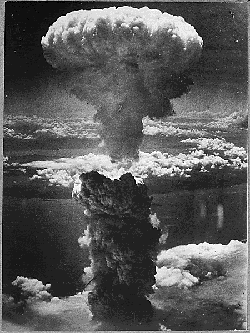 When Soyinka’s household gets a television, the news becomes a more prominent part of the family’s life, and as such, the family is able to hear more news of Hitler and World War II: “Hitler monopolized the box. He had his own special programme and somehow, far off as this war of his whim appeared to be, we were drawn more and more into the expanding arena of menace. Hitler came nearer home every day“ (109).
When Soyinka’s household gets a television, the news becomes a more prominent part of the family’s life, and as such, the family is able to hear more news of Hitler and World War II: “Hitler monopolized the box. He had his own special programme and somehow, far off as this war of his whim appeared to be, we were drawn more and more into the expanding arena of menace. Hitler came nearer home every day“ (109).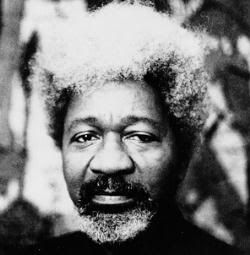 Wole Soyinka is a Nigerian writer, poet, and playwright. Some consider him Africa’s most distinguished playwright, as he won the Nobel Prize in Literature in 1986, the first African so honored.
Wole Soyinka is a Nigerian writer, poet, and playwright. Some consider him Africa’s most distinguished playwright, as he won the Nobel Prize in Literature in 1986, the first African so honored.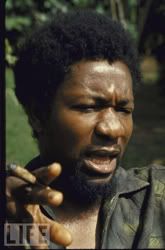
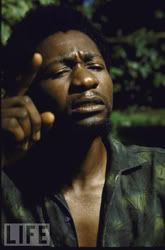 Change was impossible to predict. A tempo, a mood would have settled over the house, over guests, relations, casual visitors, poor relations, 'cousins,' strays – all recognized within a tangible pattern of feeling – and then it would happen! A small event or, more frequently, nothing happened at all, nothing that I could notice much less grasp and – suddenly it all changed! The familiar faces looked and acted differently. Features appeared where they had not been, vanished where before they had become inseparable from our existence. Every human being with whom we came into contact, Tinu and I, would CHANGE! Even Tinu changed, and I began to wonder if I also changed, without knowing it, the same as everybody else (93).
Change was impossible to predict. A tempo, a mood would have settled over the house, over guests, relations, casual visitors, poor relations, 'cousins,' strays – all recognized within a tangible pattern of feeling – and then it would happen! A small event or, more frequently, nothing happened at all, nothing that I could notice much less grasp and – suddenly it all changed! The familiar faces looked and acted differently. Features appeared where they had not been, vanished where before they had become inseparable from our existence. Every human being with whom we came into contact, Tinu and I, would CHANGE! Even Tinu changed, and I began to wonder if I also changed, without knowing it, the same as everybody else (93). And yet Mr. Soyinka, hearing the cries of Ake's market and the chime of the tower-clock; spying on the "song-master" who leads a procession of humiliated women from house to house down mean African streets, past church, cemetery, sewing academy, barbershop, repair shack, "mounted divination birds" and "elephant-topped" archways to a fake palace; eating, for joy, black-eyed beans that have been crushed and skinned and mixed with melon-seed oil, and ingesting, as a cure for the wet bed, roasted egg-nest of praying mantis; dreaming of a dead father and a shoeless child -this Mr. Soyinka somehow, marvelously, makes ambivalence cheerful.
And yet Mr. Soyinka, hearing the cries of Ake's market and the chime of the tower-clock; spying on the "song-master" who leads a procession of humiliated women from house to house down mean African streets, past church, cemetery, sewing academy, barbershop, repair shack, "mounted divination birds" and "elephant-topped" archways to a fake palace; eating, for joy, black-eyed beans that have been crushed and skinned and mixed with melon-seed oil, and ingesting, as a cure for the wet bed, roasted egg-nest of praying mantis; dreaming of a dead father and a shoeless child -this Mr. Soyinka somehow, marvelously, makes ambivalence cheerful.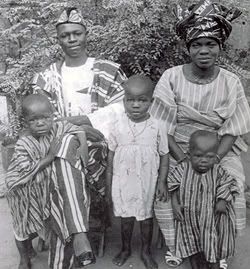 It's important that students are familiar with Nigerian geography, history, politics, and culture before reading Soyinka's memoir in earnest.
It's important that students are familiar with Nigerian geography, history, politics, and culture before reading Soyinka's memoir in earnest. 